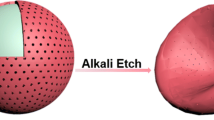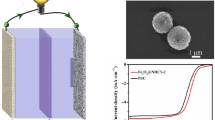Abstract
Designing high active, low cost and bifunctional electrocatalysts is urgent for developing clean energy storage and conversion systems. Transition metal selenides exhibit optimal electronic conductivity and tunable physicochemical properties, which endow them with potential for efficient electrocatalysts to facilitate the oxygen reduction and oxygen evolution reactions (ORR and OER). Herein, hollow NixCo0.85-xSe nanospheres were synthesized using a facile polyol based solution chemical method. The NixCo0.85-xSe exhibits an onset overpotential of 0.89 V for ORR, and an overpotential of 305 mV to achieve 10 mA cm−2 for OER. Moreover, the NixCo0.85-xSe based Zn-air battery displays remarkable specific capacity and durability. Such superior catalytic performances can be attributed to the synergistic effect, large specific surface area and enhanced electron transfer rate. This approach provides a new way to design highly efficient bifunctional electrocatalysts for electrochemical energy storage and utilization.
摘要
合成高活性、 低成本、 双功能特性的电催化剂是目前发展新能源材料的重要任务. 过渡金属硒化物具有较高的电导特性、 可调节的物理化学特性等, 成为了开发高效氧还原和氧析出催化剂的研究热点. 本文采用多元醇溶液化学法合成了具有较大比表面积的NixCo0.85-xSe中空纳米球. 该催化剂的ORR起始电位达到0.89 V, OER在10 mA cm−2电流密度下的过电位达到305 mV. 以NixCo0.85−xSe中空纳米球为空气电极、 锌片为阴极组成的锌空电池具有良好的比容量和循环稳定性. NixCo0.85−xSe中空纳米球优异的催化性能主要归因于较大的比表面积、 Ni和Co的协同催化特性以及良好的导电性. 本文为设计高效的锌空电池催化剂提供了良好的理论基础和实验支持.
Similar content being viewed by others
References
Wang C, Xie NH, Zhang Y, et al. Silk-derived highly active oxygen electrocatalysts for flexible and rechargeable Zn-air batteries. Chem Mater, 2019, 31: 1023–1029
Liu Z, Zhang J, Hong T, et al. High-efficiency nanorod-nanosheet arrays sandwich photoelectrode for photoelectrochemical water splitting. Int J Hydrogen Energy, 2016, 41: 13359–13367
Hao Q, Chu Y, Zheng X, et al. Preparation of planar CH3NH3PbI3 thin films with controlled size using 1-ethyl-2-pyrrolidone as solvent. J Alloys Compd, 2016, 671: 11–16
Zheng X, Cao Y, Han X, et al. Pt embedded Ni3Se2@NiOOH core-shell dendrite-like nanoarrays on nickel as bifunctional electro-catalysts for overall water splitting. Sci China Mater, 2019, 62: 1096–1104
Li H, Ji J, Zheng X, et al. Preparation of SnS quantum dots for solar cells application by an in-situ solution chemical reaction process. Mater Sci Semiconductor Processing, 2015, 36: 65–70
Dutta S, Indra A, Feng Y, et al. Self-supported nickel iron layered double hydroxide-nickel selenide electrocatalyst for superior water splitting activity. ACS Appl Mater Interfaces, 2017, 9: 33766–33774
Tian J, Liu Q, Asiri AM, et al. Self-supported nanoporous cobalt phosphide nanowire arrays: An efficient 3D hydrogen-evolving cathode over the wide range of pH 0–14. J Am Chem Soc, 2014, 136: 7587–7590
Fu G, Liu Y, Chen Y, et al. Robust N-doped carbon aerogels strongly coupled with iron-cobalt particles as efficient bifunctional catalysts for rechargeable Zn-air batteries. Nanoscale, 2018, 10: 19937–19944
Zhang Z, Liu G, Cui X, et al. Crystal phase and architecture engineering of lotus-thalamus-shaped Pt-Ni anisotropic superstructures for highly efficient electrochemical hydrogen evolution. Adv Mater, 2018, 30: 1801741
Wang T, Nam G, Jin Y, et al. NiFe (oxy)hydroxides derived from NiFe disulfides as an efficient oxygen evolution catalyst for rechargeable Zn-air batteries: The effect of surface S residues. Adv Mater, 2018, 30: 1800757
Fu G, Cui Z, Chen Y, et al. Ni3Fe-N doped carbon sheets as a bifunctional electrocatalyst for air cathodes. Adv Energy Mater, 2017, 7: 1601172
Han X, He G, He Y, et al. Engineering catalytic active sites on cobalt oxide surface for enhanced oxygen electrocatalysis. Adv Energy Mater, 2018, 8: 1702222
Li Y, Zhong C, Liu J, et al. Atomically thin mesoporous Co3O4 layers strongly coupled with N-rGO nanosheets as high-performance bifunctional catalysts for 1D knittable zinc-air batteries. Adv Mater, 2018, 30: 1703657
Chen Z, Zhao H, Zhang J, et al. IrNi nanoparticle-decorated flower-shaped NiCo2O4 nanostructures: controllable synthesis and enhanced electrochemical activity for oxygen evolution reaction. Sci China Mater, 2017, 60: 119–130
Zeng S, Tong X, Zhou S, et al. All-in-one bifunctional oxygen electrode films for flexible Zn-air batteries. Small, 2018, 14: 1803409
Han X, Cheng F, Zhang T, et al. Hydrogenated uniform Pt clusters supported on porous CaMnO3 as a bifunctional electrocatalyst for enhanced oxygen reduction and evolution. Adv Mater, 2014, 26: 2047–2051
Wang HF, Tang C, Zhang Q. A review of precious-metal-free bi-functional oxygen electrocatalysts: Rational design and applications in Zn-air batteries. Adv Funct Mater, 2018, 28: 1803329
Amiinu IS, Liu X, Pu Z, et al. From 3D ZIF nanocrystals to Co-Nx/ C nanorod array electrocatalysts for ORR, OER, and Zn-air batteries. Adv Funct Mater, 2018, 28: 1704638
Singh S, Jain S, Ps V, et al. Hydrogen: A sustainable fuel for future of the transport sector. Renew Sustain Energy Rev, 2015, 51: 623–633
Chen X, Liu B, Zhong C, et al. Ultrathin Co3O4 layers with large contact area on carbon fibers as high-performance electrode for flexible zinc-air battery integrated with flexible display. Adv Energy Mater, 2017, 7: 1700779
Lee Y, Suntivich J, May KJ, et al. Synthesis and activities of rutile IrO2 and RuO2 nanoparticles for oxygen evolution in acid and alkaline solutions. J Phys Chem Lett, 2012, 3: 399–404
Yin J, Li Y, Lv F, et al. Oxygen vacancies dominated NiS2/CoS2 interface porous nanowires for portable zn-air batteries driven water splitting devices. Adv Mater, 2017, 29: 1704681
Zheng X, Han X, Liu H, et al. Controllable synthesis of NixSe (0.5 ≤ x ≤ 1) nanocrystals for efficient rechargeable zinc-air batteries and water splitting. ACS Appl Mater Interfaces, 2018, 10: 13675–13684
Liu Y, Cheng H, Lyu M, et al. Low overpotential in vacancy-rich ultrathin CoSe2 nanosheets for water oxidation. J Am Chem Soc, 2014, 136: 15670–15675
Sivanantham A, Shanmugam S. Nickel selenide supported on nickel foam as an efficient and durable non-precious electrocatalyst for the alkaline water electrolysis. Appl Catal B-Environ, 2017, 203: 485–493
Anugop B, Prasanth S, Rithesh Raj D, et al. Role of Mn2+ concentration in the linear and nonlinear optical properties of Ni1-xMnxSe nanoparticles. Optical Mater, 2016, 62: 297–305
Lee CT, Peng JD, Li CT, et al. Ni3Se4 hollow architectures as catalytic materials for the counter electrodes of dye-sensitized solar cells. Nano Energy, 2014, 10: 201–211
Umeyama N, Tokumoto M, Yagi S, et al. Synthesis and magnetic properties of NiSe, NiTe, CoSe, and CoTe. Jpn J Appl Phys, 2012, 51: 053001
Zhang X, Zhen M, Bai J, et al. Efficient NiSe-Ni3Se2/graphene electrocatalyst in dye-sensitized solar cells: The role of hollow hybrid nanostructure. ACS Appl Mater Interfaces, 2016, 8: 17187–17193
Moloto N, Moloto MJ, Coville NJ, et al. Synthesis and characterization of nickel selenide nanoparticles: size and shape determining parameters. J Cryst Growth, 2011, 324: 41–52
Wu X, He D, Zhang H, et al. Ni0.85Se as an efficient non-noble bifunctional electrocatalyst for full water splitting. Int J Hydrogen Energy, 2016, 41: 10688–10694
Tian Y, Ruan Y, Zhang J, et al. Controllable growth of NiSe na-norod arrays via one-pot hydrothermal method for high areal-capacitance supercapacitors. Electrochim Acta, 2017, 250: 327–334
Wang Z, Li J, Tian X, et al. Porous nickel-iron selenide nanosheets as highly efficient electrocatalysts for oxygen evolution reaction. ACS Appl Mater Interfaces, 2016, 8: 19386–19392
Fang L, Li W, Guan Y, et al. Tuning unique peapod-like Co(SxSe1-x)2 nanoparticles for efficient overall water splitting. Adv Funct Mater, 2017, 27: 1701008
Swesi AT, Masud J, Nath M. Nickel selenide as a high-efficiency catalyst for oxygen evolution reaction. Energy Environ Sci, 2016, 9: 1771–1782
Fang Z, Peng L, Lv H, et al. Metallic transition metal selenide holey nanosheets for efficient oxygen evolution electrocatalysis. ACS Nano, 2017, 11: 9550–9557
Li H, Chen S, Lin H, et al. Nickel diselenide ultrathin nanowires decorated with amorphous nickel oxide nanoparticles for enhanced water splitting electrocatalysis. Small, 2017, 13: 1701487
Hu X, Chen Y, Zhang M, et al. Alveolate porous carbon aerogels supported Co9S8 derived from a novel hybrid hydrogel for bi-functional oxygen electrocatalysis. Carbon, 2019, 144: 557–566
Subbarao U, Marakatti VS, Amshumali MK, et al. Size and morphology controlled NiSe nanoparticles as efficient catalyst for the reduction reactions. J Solid State Chem, 2016, 244: 84–92
Zheng X, Jin Z, Liu H, et al. Phase-controllable synthesis of CuxS nanocrystals by an ambient pressure tetraethylene glycol solution process. Synth Met, 2013, 169: 25–32
Zheng X, Han X, Zhang Y, et al. Controllable synthesis of nickel sulfide nanocatalysts and their phase-dependent performance for overall water splitting. Nanoscale, 2019, 11: 5646–5654
Zheng X, Jin Z, Liu H, et al. Single-phase and well-dispersed Cu1.75S nanocrystals by ambient pressure diethylene glycol solution synthesis. Appl Surf Sci, 2012, 266: 39–45
Han X, Wu X, Zhong C, et al. NiCo2S4 nanocrystals anchored on nitrogen-doped carbon nanotubes as a highly efficient bifunctional electrocatalyst for rechargeable zinc-air batteries. Nano Energy, 2017, 31: 541–550
Li Y, Yin J, An L, et al. Metallic CuCo2S4 nanosheets of atomic thickness as efficient bifunctional electrocatalysts for portable, flexible Zn-air batteries. Nanoscale, 2018, 10: 6581–6588
Li Y, Zhou W, Dong J, et al. Interface engineered in situ anchoring of Co9S8 nanoparticles into a multiple doped carbon matrix: highly efficient zinc-air batteries. Nanoscale, 2018, 10: 2649–2657
Chang J, Xiao Y, Xiao M, et al. Surface oxidized cobalt-phosphide nanorods as an advanced oxygen evolution catalyst in alkaline solution. ACS Catal, 2015, 5: 6874–6878
Stern LA, Feng L, Song F, et al. Ni2P as a Janus catalyst for water splitting: the oxygen evolution activity of Ni2P nanoparticles. Energy Environ Sci, 2015, 8: 2347–2351
Zheng X, Zhang Y, Liu H, et al. In situ fabrication of hetero-structure on nickel foam with tuned composition for enhancing water-splitting performance. Small, 2018, 14: 1803666
Acknowledgements
This work was supported by the National Natural Science Foundation of China (51804216). Zheng X acknowledges a scholarship from the China Scholarship Council (CSC) (201806255078).
Author information
Authors and Affiliations
Contributions
Author contributions Zheng X and Han Y designed and engineered the samples; Zhang J and Zhang Z performed the experiments; Han Y performed the characterizations of SEM, TEM and XRD; Zheng X, Wang J and Hu W helped analyze and discuss the data; Zheng X wrote the manuscript with support from Han Y.
Corresponding author
Ethics declarations
Conflict of interest The authors declare no conflict of interest.
Additional information
Xuerong Zheng is a PhD student in the School of Materials Science and Engineering at Tianjin University. His recent research interests focus on the development of electrochemical metallurgy methods for preparing micro/nanostructured materials for electrochemical and electrocatalysis applications.
Yajing Han is an associate professor in the School of Materials Science and Engineering, Tianjin University. Her expertise is in the SEM, TEM and XRD analyses. Her research interests include metal and metal oxide nanostructures for electrochemical and energy applications.
Rights and permissions
About this article
Cite this article
Zheng, X., Zhang, J., Wang, J. et al. Facile synthesis of nickel cobalt selenide hollow nanospheres as efficient bifunctional electrocatalyst for rechargeable Zn-air battery. Sci. China Mater. 63, 347–355 (2020). https://doi.org/10.1007/s40843-019-1203-0
Received:
Accepted:
Published:
Issue Date:
DOI: https://doi.org/10.1007/s40843-019-1203-0




